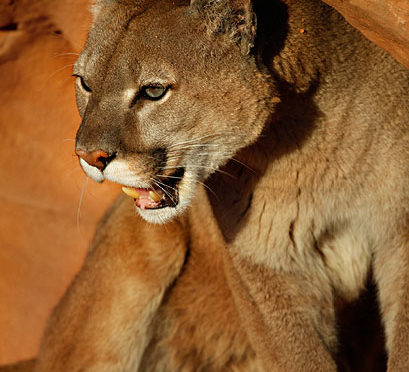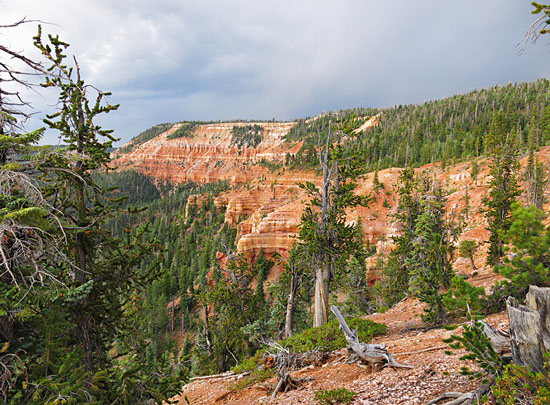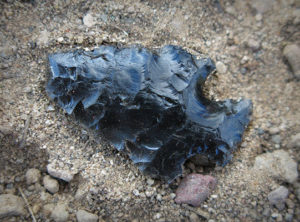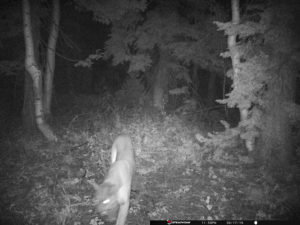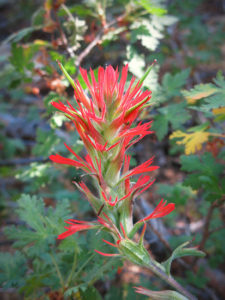Cougars Abound
The deer herd in my Southern Utah hunting area is on the decline thanks to a long-running drought, in conjunction with an ever-increasing human presence. Locating any remaining bucks means relying on an array of trail cameras placed along known deer routes across the mountain range. Every year we capture one or two photos of cougars prowling around, but last season was different. Over the course of a single month we captured cougar pictures on all four cameras.

Of course you’ll find cougars wherever deer are concentrated, but in recent years we’ve been seeing more and more cougar sign including deer kills, paw prints, clawed-up trees, and of course trail-cam photos.
My theory is that when deer numbers decrease rapidly, cougars (commonly referred to as mountain lions) are forced to roam over more territory in search of their most common prey, the mule deer. This, of course, increases the odds of running into a big cat while hunting. To make matters worse, when deer numbers are down, hungry cougars will actually consider humans as prey, although attacks are quite rare.

In three decades of deer hunting I’ve only seen a handful of cougars. About half were seen at night by headlights on remote dirt roads, the other half up and prowling during daylight hours. It wasn’t until the 2021 deer season that I actually came face-to-face with a lion in the woods and was even forced to defend myself.
The Cougar Attack
It all began halfway through last season’s bowhunt. It was just another hot afternoon as Esther and I trudged up a dusty trail leading to a pine ridge where we like to hunt. Esther was excited to show me some trail-cam photos of a decent 3-pointer from earlier in the week. Sweating and puffing from the steep hike, we settled down on a log and began scrolling through the photos.
We’d only been there a minute or two when a series of blood-curdling screams and a loud scuffling sounds broke the silence about 50 yards into the heavy timber. At first I thought it was another hunter-jackass messing with us. However, the screams grew louder and morphed into what sounded like a sheep in distress…or at least something very non-human. Esther and I sat frozen, staring blankly at the timber. Seconds later everything was silent.
At that point it I figured it must have been a cougar attack and said to Esther, “I think a deer just got whacked by a cougar….” Of course I’d never actually heard a cougar attack on a deer, but what else could it be? Sasquatch, maybe?
As a self-proclaimed naturalist I was overcome by curiosity and stood up, saying, “Hey, let’s go take a look.”
“I’m not going over there!” was Esther’s immediate reply.
“Just stay behind me. If it’s a lion he’ll just run off.”
Everyone knows that big cats out West are naturally afraid of people and take every precaution to avoid humans. This is reinforced by the fact that humans are the cougar’s only natural predator. But I can’t fault Esther for being nervous. Only two years previous she had a very unnerving encounter with a lion on another trail. In the gray hours of morning she came around a bend at the exact same time a cougar was coming from the opposite direction. The cougar didn’t run away, but instead crouched low and stared at Esther from only fifteen yards away. Following the standard cougar-avoidance protocol, Esther yelled and waved her arms to scare it off. When that didn’t work she loaded an arrow and drew her bow. When he still didn’t budge she released the arrow which skipped off the dirt right next to the cat. Instead of running away, he just turned and walked casually into the woods.

A dangerous cat is a danger indeed. Due to their explosive short-burst speed, there is no physical way to outrun a cougar. They can grow to roughly the same size and weight (and color) as an adult human; a full-grown male lion can weigh more than two-hundred pounds. Cougars prefer ambush-style hunting: crouching in wait and then pouncing on his victim. He uses his powerful arms to pull down his prey, and then kills quickly by sinking his fangs into the back of the neck and severing the spine. Other tactics include crushing the windpipe and suffocating his victim. Either way it’s a quick and silent death. Your best chance at surviving a cougar attack is to fight back. If at all possible, go for the eyes. Cats are very careful to avoid personal injury and will back off if you threaten bodily harm.

Now back to our story.
Cautiously we tiptoed into the timber in the direction of the scuffle. Coming around a clump of stunted pines we found a yearling doe lying flat on the ground, gargling and gasping with its eyes rolled back in its head. Claw marks were raked horizontally across her hind quarters. The cougar had obviously heard us coming and ran off before we arrived.
Instinctively I loaded an arrow while Esther suggested what I was thinking anyway: “Maybe we should put it out of its misery.” But I decided to wait since, strangely, there was no blood present. About twenty seconds later, the deer’s eyes rolled back into place. She suddenly swung her head up, looked around, then sprang to her feet and bounded away as if nothing happened.
At that point we slowly backed out and into the open. On the way out I joked, “Looks like I saved a deer’s life. She better send us a thank you card in the mail.”

Esther was planning to hunt this area in the evening, but after the nerve-wracking experience she decided to follow me into a different area instead. On the way I joked that the cougar might be plotting revenge for having his dinner plans ruined. In retrospect I was only half-joking, because that’s exactly what the cougar did! Before splitting up for the evening, I suggested she sit with her back to a tree and keep an eye behind her. But the evening was uneventful and at dark we walked back to the truck together.
A Vengeful Cougar?
Twenty-four hours later I found myself once again huffing and puffing up the mountain alone, this time about a mile away. I was thoroughly focused on deer; the cougar encounter already ancient history in my mind. After all, what were the odds of running into the same cat, even if he was now desperately hungry and maybe even seeking revenge?

I arrived at one of my favorite areas and immediately spotted two forest grouse pecking around. Realizing that any meat was better than no meat, I stalked toward the bigger bird. He got nervous, however, and flew into the low branches of a nearby tree. Moving closer for a shot, I settled my pin on the little target and released. POOF! The grouse fell to the ground in a shower of clipped feathers. Excitedly I trotted over to collect my bird, but to my dismay he was gone; apparently just a grazing shot. From there I walked in ever-widening circles around the trees scanning for the bird.
A moment later I spotted a grouse walking across a flat towards some nearby cliffs. I followed the bird, but when I got closer he busted from the cliff edge and soared into the wilderness 1000 feet below. Realizing it must have been the other bird, I turned back to look for the one I’d shot at.
But when I turned around my heart stopped. Sitting in the shadows, half-hidden behind a deadfall tree and exactly where I’d been standing just a minute earlier, was a big cougar staring right at me. Only his head and muscular shoulders were visible above the log, his eyes locked on mine. It didn’t seem real at first, and all I could do was stare back as my mind raced, trying to make sense of the situation. Was it real or someone playing a trick on me? Now what?

Defend Yourself!
The hackles on my neck suddenly stood on end as I realized the gravity of the situation. First off, I was standing in the wide open with sheer cliffs at my back. Second, the cougar wasn’t budging and likely contemplating his next move. Finally, in all likelihood he was the same cougar from the previous night, now hungry and vengeful. At any moment I expected the great cat to explode across the flat in a tawny blur and rip me to shreds.
Without another thought I quickly and smoothly grasped an arrow from my quiver and loaded it onto my bow without looking down. Then, in one fluid motion I drew my bow while calculating the distance to the cougar. My sight pins scrolled across his face. Looks about thirty yards…
A second later my arrow whizzed into the shadows and found its mark with a loud CRACK!
The cougar disappeared into a flurry of dust and debris, its tail whipping wildly above the log. Instantly I pulled another arrow, this time fumbling to load it with my shaking hand. The scuffling suddenly stopped. Was he dead?
Nope.
The cat sprang up on another log situated perpendicular to the one he’d been sitting behind. Without looking back he casually walked the length of the log in the opposite direction, then hopped to the ground and meandered into the trees as if nothing happened.
I waited until the cat was well out of sight and then walked over to where he’d been sitting. There was no blood or arrow at first, just a few tuffs of tan fur mixed with pine needles and branches. A short distance later the blood trail started, dark red and drizzled steadily along the log and off into the woods.
For the moment I had no intention of following the cat, and instead spent some time looking for my arrow, the whole time wondering where I’d hit him. It was clearly a good hit, but there was no evidence that the arrow passed through, nor did he carry it off. The only possibility was the arrow hit him high on the head, a glancing, slashing blow that knocked him temporarily senseless, and then skipped into the woods.

At last I cautiously followed the blood trail into the woods. It was my responsibility, after all, to follow-up on a wounded animal. The easy-to-follow drizzle trail continued for about 300 yards and then stopped abruptly as the forest grew thick with minimal visibility. At that point, and with darkness falling fast, I decided that following an injured, man-stalking cat into the thick stuff was a bad idea and backed out.
In the End
Interestingly, I returned to the site in the morning and found an entirely new blood trail. This blood was from a deer, however, its dug-in tracks intermingled with that of a cougar who’d apparently taken it down very near the same location as my encounter. Was it the same cat? We’ll never know.
Although I continued to hunt the same general area for the next couple weeks I never saw the cougar again, nor did I expect to. He learned a valuable lesson that day: To associate people with danger. Still, I’m looking forward to next season. If we meet again he should be easily identifiable; perhaps I’ll name him “scar.”

